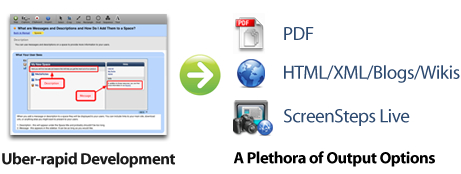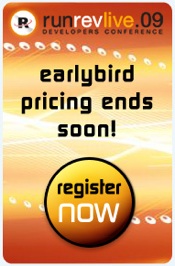

ScreenSteps Support Suite
Provide Exceptional Customer Support with Limited Resources
Last month Blue Mango Learning Systems released the ScreenSteps Support Suite. The ScreenSteps Support Suite allows companies and organizations to dramatically improve their customer support with a minimal investment of time and resources. With the recent launch of Revolution Data Grids, I have been using the ScreenSteps Support Suite to create, update and distribute the Data Grid documentation from its initial beta through product launch and maintenance. In this article I will explain the methods and tools available in the suite which have made it possible for me to provide exceptional documentation while juggling development, release and maintenance of the Data Grid control and our own ScreenSteps 2.5 software. And all of this within the same month.
The ScreenSteps Support Suite
The ScreenSteps Support Suite is built around a simple philosophy: each step of providing instruction to a customer should be easy. It should be easy to create customer tutorials and guides. It should be easy to publish them. It should be easy to deliver to the customer. And it should be easy for the customer to understand the information they are given. And that is what the ScreenSteps Support Suite does, it makes it easy to turn customer support into customer satisfaction.

So how did I get the Data Grid documentation up and running right away and meet all of the goals above? I just kept these two concepts in mind:
1) Connect the dots.
2) Plan not to plan.
Before I explain what "connect the dots" and "plan not to plan" mean in the context of customer support lets take a look at what makes up the ScreenSteps Support Suite. The suite consists of two components: ScreenSteps Desktop and ScreenSteps Live. ScreenSteps Desktop focuses on content creation and export and ScreenSteps Live focuses on publishing, collaboration and distribution.
Content Creation and Export
ScreenSteps Desktop version 2.5 is the content creation and editing module of the ScreenSteps Support Suite. With ScreenSteps Desktop, users of any ability can quickly create customer tutorials and guides that any customer can follow. The key is that it is very fast to create a visual step-by-step guide.
Publishing, Collaboration and Distribution
ScreenSteps Live is the hosted publishing, distribution and collaboration component of the suite. While ScreenSteps Desktop is designed as a tool to create original content, ScreenSteps Live allows me to quickly publish, distribute and reuse the content I create with ScreenSteps Desktop.
When you combine the streamlined content creation process of ScreenSteps Desktop and the powerful publishing and distribution features of ScreenSteps Live customer support becomes easy.
• You can create content in minutes.
• You can quickly assemble that content into manuals.
• You can publish those manuals to ScreenSteps Live with a single click.
• You can add new lessons to your manuals at any time.
• You can collaborate among team members via ScreenSteps Live to divide up the lessons that need creating and updating.
The ScreenSteps Support suite provides the tools you need to provide excellent customer support. But tools are only useful if you know how to use them so let's look at how I used the concepts of "connect the dots" and "plan not to plan" to create and expand my support materials.
Connect The Dots
Connect the Dots drawings are an interesting means of allowing children with little or no artistic experience to produce a drawing they could not otherwise create. The "artist" simply starts at number 1 and draws a line to number 2. Then 2 is connected to 3 and so on and so forth until the drawing is completed.
The concept works because an understandable, easy to follow plan is laid out. But what would happen if a 5-year old sat down to draw and saw "1,2,3,4,29"? Once he got to 4 where would he go next?
Have you ever been reading through documentation only to be frustrated by "missing numbers"? You find these "missing numbers" in documentation all of the time and it can be very frustrating for the person trying to follow along. This is not the experience you want for your customers especially since a "missing dot" means an email or call to customer support.
Teach Tasks, Not Features
You can connect all of the dots with your documentation by focusing on tasks rather than features. By telling your customers how to do something as opposed to what your program does you are helping them get real work done. They no longer have to figure out how to translate features into meaningful output.
Plan Not To Plan
Now that you know how to connect the dots for your customers you need to decide how you are going to produce the actual content. This decision is critical as it may decide whether or not your documentation ever sees the light of day.
If you spend all of your time planning your documentation it will never get done. You are probably not on a documentation team. You wear a lot of different hats and each one pulls you in a different direction. Documentation will always be the last thing on your list. This is why you should plan not to plan.
The "plan not to plan" method allows you to skip the long drawn out (and many times useless) planning stage and get right to creating content that will improve your customer support. Here is how it works:
- Write down the questions customers have asked.
- Create lessons in ScreenSteps Desktop that answer those questions.
- Post the answers as a manual to ScreenSteps Live.
- When a customer asks a new question do one of two things:
* If you have a lesson that answers the question then send it to them.
* If you don't, create one, add it to the manual and then send it to them.
The power of the ScreenSteps Support Suite is the ability to create documentation as you go. Start by just creating something, anything and making it available to your customers. You can then add to your customer support materials as needed.
The "plan not to plan" system works because it answers actual questions your customers have. By following it you teach relevant tasks that satisfy customer needs. In addition you don't end up writing a lot of content that won't ever get used again. The lessons are easy to update because they focus around a specific task. Plus you can quickly respond to customer questions and provide excellent customer support.
Putting It Into Practice
As I mentioned earlier I use "connect the dots" and "plan not to plan" with the Data Grid documentation. When the first beta of the Data Grid was released there were only a handful of lessons available in the manual. Some of the lessons were pretty rough as well. But there was a manual and it provided a starting point. Users began commenting on lessons using the ScreenSteps Live commenting feature. As they asked questions on existing lessons I would revise the lesson and make improvements. Because these iterations were spread out over time and based on actual user feedback they were easier to make.
Once the Data Grid was released people started asking how to do different things with it. Someone wanted to know how to use an option menu in a table cell. Another person wanted to know how display line numbers in a table and someone else wanted to know how to get aggregate values for columns. Each of these questions was answered by creating a new lesson in ScreenSteps Desktop and then updating the manual on ScreenSteps Live by clicking a single button. You can see these lessons in the manual:
• How Can I Store An Option Menu Value When The User Makes a Selection?
• How Do I Display Line Numbers in a Table?
• How Do I Get Aggregate Values for Columns?
Custom Satisfaction
Customer support can be one of the most time consuming things you do as a developer. But the ScreenSteps Support Suite you can not only get it done but you can turn customer support into customer satisfaction.
You can get the latest Screensteps here:
|





